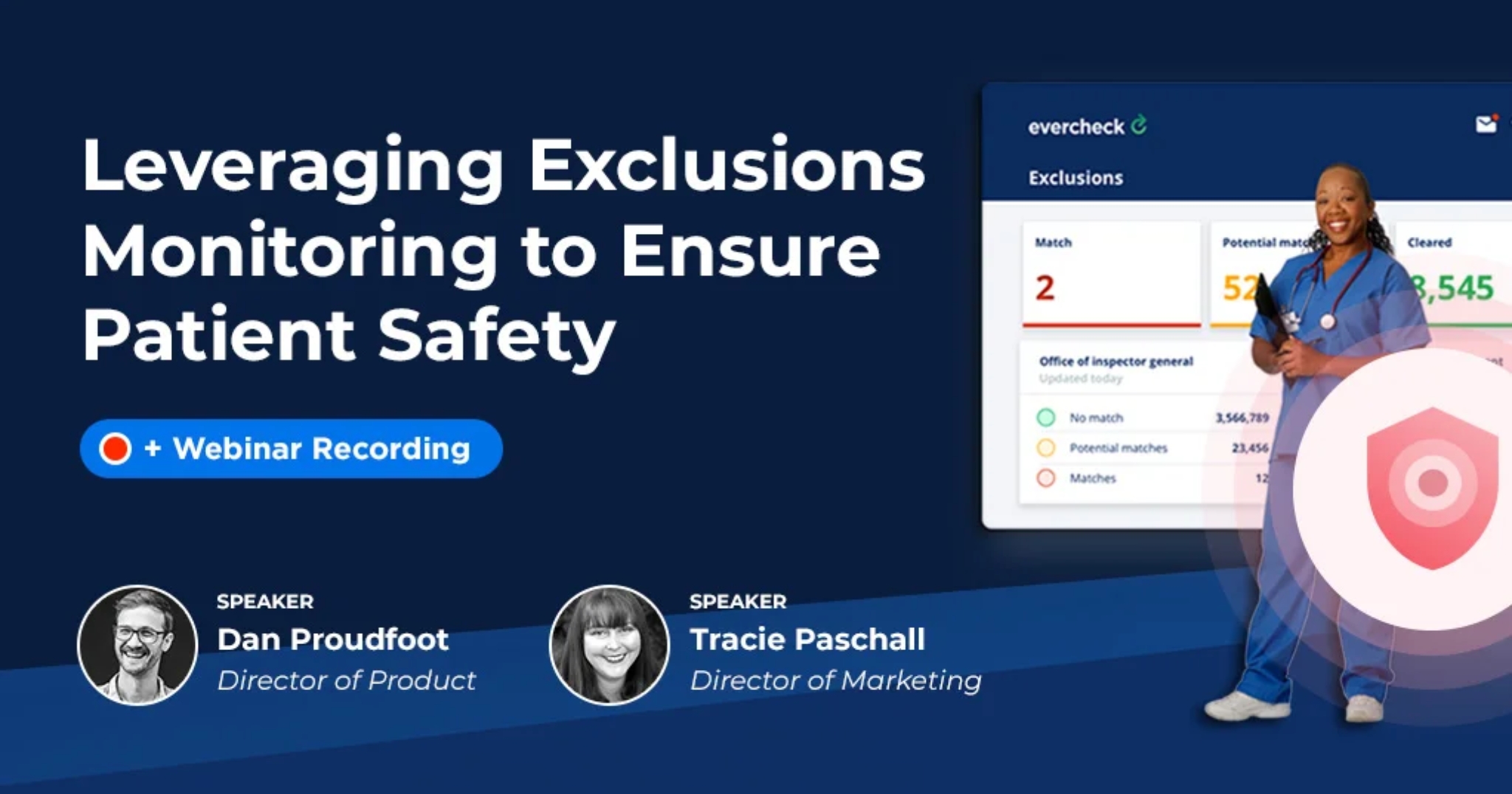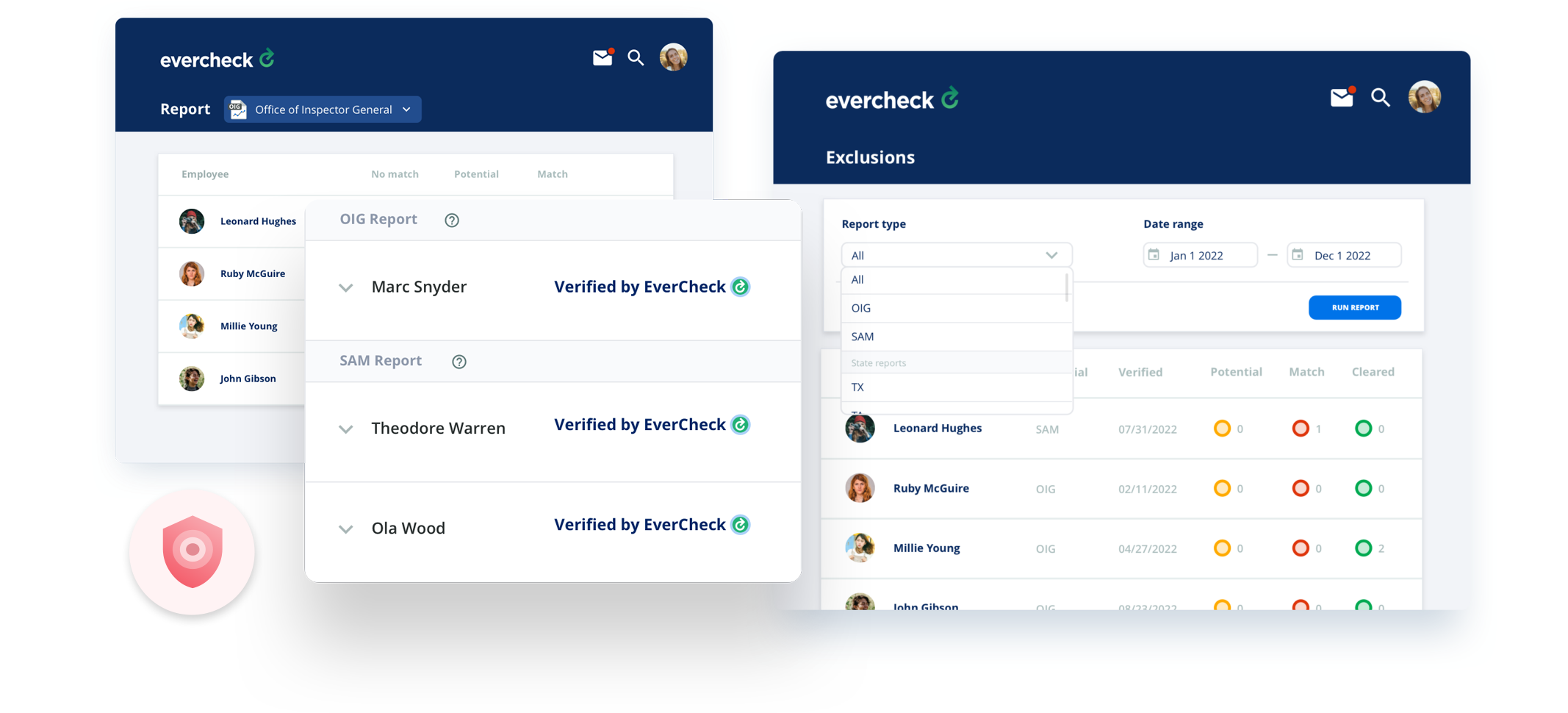Webinar Session:
Leveraging Exclusions Monitoring to Ensure Patient Safety
Wednesday, December 14, 2022
Topics covered:
- Back to Basics: Exclusions Monitoring
- Best Practices
- EverCheck’s Approach to Monitoring
Back to Basics: Exclusions Monitoring
What it means to be excluded
The OIG mandates that healthcare organizations do not hire or do business with “excluded or sanctioned” individuals, entities, or vendors. Excluded individuals and entities cannot participate in or receive payment from federally funded programs like Medicare and Medicaid.
Hiring a provider in violation of exclusion lists may result in fines and civil monetary penalties (CMP) per item claimed or service provided by the excluded process.
Exclusions vs sanctions
Exclusions are escalated measures or extreme sanctions issued by the OIG or a state licensing board against individuals or entities.
Sanctions are disciplinary actions levied against an individual or an entity by a state licensing board.
Federal and state exclusion authorities
There are several federal and state exclusion authorities. The key players are Office of the Inspector’s General’s (OIG) List of Excluded Individuals and Entities, General Services Administration, and forty-three state sources.
Grounds for exclusion
Individuals or entities can be excluded for various reasons. The OIG breaks exclusions into two categories: mandatory and permissive.
Mandatory: By law, the OIG must exclude individuals and entities convicted of certain types of criminal offenses from participating in all Federal healthcare programs. Offenses that fall into the mandatory exclusion category include felony convictions for Medicare or Medicaid fraud, patient abuse or neglect, controlled substances, and more. Mandatory exclusions hold a minimum penalty of five years.
Permissive: Permissive exclusions are discretionary. Although not required by law, OIG may exclude individuals and entities for misdemeanor convictions related to healthcare fraud, the unlawful manufacture, distribution, prescription, or dispensing of controlled substances, and more. This exclusion type holds an average penalty of one to three years.
See a comprehensive list of mandatory versus permissive exclusions here.
Best Practices
1. Taking a Proactive Approach
Create an environment that prevents fraud and misconduct with steps to catch disciplinary actions or sanctions before they escalate to exclusion with daily license verification. When verifying licenses with the primary, it’s preferred to verify daily to capture issues like disciplinary actions and elapsed licensure that could lead to an exclusion.
2. Verifying Monthly Against All Sources
Ensure you’re verifying your employee and vendor rosters against federal and state sources at the time of hire and monthly. The OIG updates the LEIE monthly, so checking each new list is imperative. It’s also important to verify at the time of hire. Many background checks will search federal lists, but it’s imperative that state lists are also checked.
3. Utilizing Automation
Checking every provider and vendor in an organization against various exclusion authorities monthly can be daunting. It’s time-consuming, increases the chance of human error, and may limit you from screening monthly. An automated solution helps to ease the administrative burden, reduce human errors, increase efficiency, and ensure protection from fraud. An automated solution that screens your employee and vendor roster on your behalf can deliver potential and highly accurate matches.
4. Keeping Digital Records
Keeping digital records is a great way to be audit ready, with easy access to exclusion checks and employee records. With digital records, you can easily provide proof of compliance.
EverCheck’s Approach to Monitoring
EverCheck has provided exclusion monitoring services since 2014, using best-in-class search technology to cross reference your employee/vendor roster with the primary sources automatically.
We deliver a list of potential matches for your team to easily review, that way you can focus on addressing matches versus finding them.
Exclusions monitoring in combination with our daily verification service offers a holistic approach to compliance that gives you confidence in your employees eligibility to work.
Still, have questions about OIG exclusions? Click here for additional FAQs.
Curious about learning more? Still, have questions? Ready to get support monitoring?


